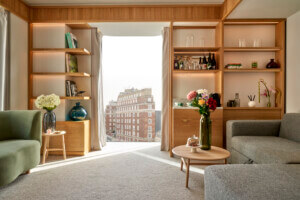The recent uptick in timber construction across the globe has led to a wave of innovation as firms test the material’s limits by building taller, bolder structures each and every day. In just the past year, timber has been transformed into stadiums, pre-fab homes, and even entire neighborhoods. The Architectural Association School of Architecture (AA) in London hopes to build on this momentum with the launch of its AA Wood Lab, a research center in which scientists and practitioners will come together to transform the future of timber.
The Wood Lab will function as part of Hooke Park, the AA’s woodland campus in Dorset, U.K., with the overarching goal of educating architects in the sustainable use of timber for building projects and other research capacities. Guided by a problem-solving approach, the Wood Lab will combine the latest technologies in science, design, and fabrication in order to develop building strategies that pair with the inherent properties of wood.
Zachary Mollica, Warden of AA School’s Hooke Park campus, looks forward to the wide-ranging benefits of timber research: “As architects grapple with the need to reduce the negative environmental impact of making buildings, there is no better moment for the AA to further take a leading position in the use of timber within the built environment,” Mollica, who will direct the lab, told AN. “Timber is one of our first building materials, and its carbon locking potential has unparalleled ecological benefits of increasing contemporary relevance given pressing climatic concerns.”
In Mollica’s view, timber is intimately tied to Hooke Park, as founder John Makepeace and Parnham College were ahead of the curve in realizing the potential of timber construction: They worked closely with architects and engineers like Frei Otto, Richard Burton, and Ted Happold to construct the campus’s first buildings.
The Wood Lab recently opened applications for research fellows and team members. In the coming months, founding members will lay the groundwork for long-term research aimed “beyond conventional architectural thinking,” working closely with partner organizations in the process. First in the lineup is a retrospective analysis of projects in Hooke Park by both Parnham College and the AA, ending with the launch of a print publication as the foundation for the Wood Lab’s work to come.
For a timber buff like Mollica, the launch is an exciting step in shedding light on a long-underestimated material: “Timber for me is simply the most interesting material we have available—and there is good reason I will always want a wooden desk. Timber’s incredible complexity derives from its formation as a living being. It is a material that we have a long social and cultural connection to.”
The Wood Lab was made possible thanks to the generous support of John Makepeace, who as director of Parnham College founded the Hooke Park campus, which was turned over to the AA in 2000.
The creation of the Wood Lab is part of a broader initiative at the school launched by director Eva Franch i Gilabert, the AA Residence.
“The AA Residence allows for new experimental forms of research to emerge,” said Franch in a statement, “at the intersection of academia and practice, opening up a new space for innovative ideas that can radically change the way we think, build and shape the future.”











